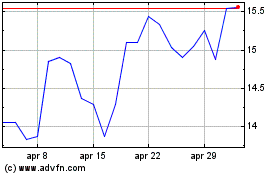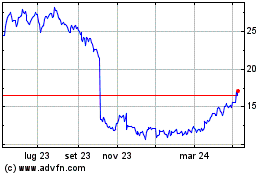By Ted Mann
HORNELL, N.Y. -- The future of American high-speed rail is
sitting in a building older than the Battle of Gettysburg: a
cavernous factory that holds the first shells of a $2 billion fleet
of Amtrak Acela trains due to begin running from Washington, D.C.,
to Boston two years from now.
Even as Congress moves toward renewed debates over the future of
both Amtrak and high-speed rail, the first of 28 new Acela train
sets are starting to take shape here. They are the first new
generation of passenger trains on the railroad since the Acela's
debut in 2000.
For Amtrak, that means a chance to relaunch a service that has
been both a commercial success and a procurement headache -- and
still the nearest approximation in the U.S. to the high-speed
trains that whisk travelers among major cities in Europe and
Asia.
Amtrak is buying 28 new sets of power cars and passenger coaches
from French manufacturer Alstom SA, which is assembling the trains
at its complex of plants in New York's Southern Tier. The train
model, known as Avelia Liberty, is from a family of trains already
in use in France and Italy, Amtrak executives say.
The new trains will be slowly entering the existing Acela
service and will have a top speed of 160 miles an hour, up from 150
miles an hour on the current fleet. The trains will be built to
tilt up to 6.3 degrees, allowing trains to run faster in curves and
save energy by avoiding braking for some turns.
Average speeds will be much lower, since the Acela will still
run on the Northeast Corridor, whose curves will limit trains to
top speed in just a few spots. And unlike high-speed trains in
Europe and Asia, the Acela shares tracks with commuter trains and
freight lines, requiring it to reduce speeds. The new trains will
be capable of going up to 186 miles an hour if tracks are later
upgraded, Alstom says.
The new Acelas will be just one meter (about three feet) longer
than the current trains, but with shorter power cars and redesigned
passenger cars. Amtrak says they will carry one-third more
passengers with a maximum capacity of 378, up from the current
304.
Amtrak says the new trains will have upgraded interiors,
including outlets and USB ports at each seat and wheelchair
accessibility in every restroom. The railroad also said the
lightweight design will improve efficiency by 20%, while a
regenerative braking system will return some power to the overhead
catenary wire system. Track improvements and the new trains'
suspension system will allow for a smoother ride, Amtrak says.
The first of the 28 new Acelas is scheduled to enter service in
summer 2021, replacing the existing fleet of 20 trains by the end
of 2022. Amtrak says the larger fleet will allow more frequent,
half-hourly Acela service at peak periods.
Eventually, railroad officials say they could offer limited-stop
and nonstop service between Washington and New York.
The railroad is hoping for a smoother launch than the first time
around. The first Acela train set was delivered to Amtrak in
October 2000, more than one year late, by a consortium of Alstom
and Canada's Bombardier Inc.
Amtrak pulled Acela trains from service in 2002 after cracks
developed in critical shock absorbers. Amtrak and the consortium
filed dueling $200 million lawsuits, which were later settled.
In 2005, Amtrak pulled the trains from service again after
cracks were found in braking equipment. The trains returned to
service after the trouble was traced to a supplier.
Despite the complications, the Acela became a success. Even
without meeting the target time of two hours, 11 minutes between
Washington and New York, the railroad succeeded in peeling
passengers away from airline shuttles. Acelas carried more than 3.4
million passengers in fiscal 2018, and Amtrak said adjusted
operating earnings for Acela trips was $318.8 million, more than
60% of the $524.1 million Amtrak earned overall on the Northeast
Corridor.
For its new Acela fleet, Amtrak selected Alstom alone, using a
$2.45 billion federal loan from the Federal Railroad
Administration. Amtrak says it will pay back the loan entirely with
revenues from its Northeast Corridor operations, with no need for
federal grants.
Roughly $2 billion of the loan will pay for the 28 train sets,
spare parts, management and contingency costs, and service
upgrades, an Amtrak spokeswoman said. Other funds will go toward
safety improvements and upgrades to tracks and stations.
Alstom says 95% of the trains' content are produced in the U.S.,
in keeping with the Buy America provisions of Amtrak's loan. But
the railroad did receive a waiver to import the extruded aluminum
shells of the passenger cars, whose honeycomb structure helps limit
the trains' weight and improve efficiency, from Alstom's factory in
Savigliano, Italy.
In Hornell, the Amtrak contract is changing the face of a
factory complex that dates to the dawn of the railroad age. Hornell
has been a center for railroad manufacturing, and the boom-and-bust
cycles of that industry, since the New York and Erie Railroad
opened a locomotive plant in 1850.
One April morning, workers in a massive plant built in 1860 were
working on an overhaul of a light railcar from Baltimore, while an
adjoining building held the final few double-decker commuter
coaches from a fleet Alstom is refurbishing for the Massachusetts
Bay Transportation Authority.
Alstom is the largest employer in town. Its three plants around
Hornell employ about 800 people, of whom about 250 are working on
the new Acela fleet, a company spokeswoman said.
Alstom recently broke ground on a new building to house Acela
equipment for its formal acceptance by Amtrak, bought a new shunter
locomotive capable of pushing around the million-pound completed
trains, and doubled the length of an existing test track, to 1.4
kilometers (just under a mile), including a new bridge over the
adjacent, flood-prone Canisteo River.
At peak capacity, the Hornell factories will be producing a
passenger car a day, one power car every five days, and one cafe
car every 10 days, said Michael MacDonald, the company's managing
director for high-speed trains in North America.
Amtrak and Alstom officials both say they hope that the
railroad's big investment will help foster the growth of an
American supply chain for high-speed rail equipment. The absence of
such a supply network raised costs and limited design choice for
the original Acela, and railroad officials blamed reliance on a
narrow, specialized supplier base, in part, for the 2005 disruption
in Acela service.
Alstom says the Amtrak contract is helping seed new expertise in
their industry.
Mr. MacDonald noted the example of TTA Systems LLC, which has
worked with Alstom in Hornell for years. TTA Systems is now
building the tilting "bogies" -- the crucial assemblies that
connect to train cars and carry their wheels.
"They've overhauled 30-year-old bogies for years that are on a
metro car that's going 30 miles an hour," Mr. MacDonald said. "This
is going to 170 miles an hour, and it's going to tilt. It's a
different animal."
Write to Ted Mann at ted.mann@wsj.com
(END) Dow Jones Newswires
May 12, 2019 08:14 ET (12:14 GMT)
Copyright (c) 2019 Dow Jones & Company, Inc.
Grafico Azioni Alstom (EU:ALO)
Storico
Da Mar 2024 a Apr 2024

Grafico Azioni Alstom (EU:ALO)
Storico
Da Apr 2023 a Apr 2024
